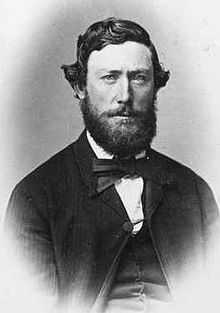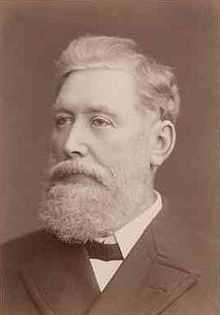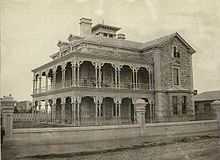Andrew Tennant (pastoralist)


Andrew Tennant (20 June 1835 – 19 July 1913) was a Scottish-born Australian pastoralist, businessman and politician.[1]
Early years
Andrew was born on 20 June 1835 at Hawick, Roxburghshire, Scotland, to John Tennant and his wife Jessie Aitken. Soon after they migrated to South Australia with an assisted passage, arriving in either the Duchess of Northumberland[1] or the Duchess of Sutherland with John Colton[2] on 19 December 1839. Andrew was educated at E. W. Wickes' school in North Adelaide.
John began "pastoral pursuits", initially at Dry Creek on the Adelaide Plains, and then at Chain of Ponds in the Adelaide Hills, Lyndoch Valley in the Gumeracha district, and Burra. John became the first person to successfully move stock overland from Adelaide, via Port Augusta to Port Lincoln at the southern tip of Eyre Peninsula. He purchased Tallala station, 15 miles (24 km) from Port Lincoln, from a Mr. White of White Park, and raised cattle and sheep there for many years.[3]
In 1853, Andrew commenced his own "pastoral pursuits", taking cattle west from Port Lincoln and settling for seven years on an abandoned site near Elliston, before owning several stations on southern Eyre Peninsula at Mount Wedge, Coffin Bay, and Streaky Bay.
On 28 August 1862 he married Rachael Christina Ferguson in Adelaide.
Pastoralist
In 1866 he leased "Baroota" near Port Germein, and subsequently bought and sold a number of properties in the mid-north, north-east and far-north of South Australia, resulting in him owning a number of large stations of over 1,000 square miles (2,600 km2) in area. Although initially interested in cattle, he also developed an interest in sheep, and owned land further south near Riverton, and a number of stations in New Zealand. In 1880 his eldest son John moved to New Zealand where they took up 25,000 acres of pastoral land.[2] Andrew also owned a number of properties in the city of Adelaide.
Tennant and James Moseley in 1904 acquired and re-established the 1,487 square miles (3,851 km2) Yardea Station in 1904 after it had been abandoned a few years earlier.[4]
Businessman
Tennant was a director of the Adelaide Steamship Co. Ltd. from its inception, a justice of the peace, a Freemason, and was heavily involved in breeding, raising and racing thoroughbred horses. He also held interests in coal mines and gold mines.
Politician
From 1881-87 Tennant represented the seat of Flinders in the South Australian House of Assembly. He then moved to the Legislative Council where he represented the Northern District from 1898-1902.[2]
Later years
Tennant died of diabetes and senile dementia in his home, Essenside, (Moseley Street, Glenelg), on 19 July 1913, and was buried in the Brighton cemetery. He was survived by his wife, three daughters and three of his four sons.[5]
John Tennant
Eldest son John moved to New Zealand in 1880. In 1898 it was reported that "he has been residing there for the last 18 years, he took up 25,000 acres of pastoral land".[2] In 1913 he was reported as "Mr. John Tennant of Princess Royal Station";[5] in 1939 as "John who lived at Kooringa".[6]
F Tennant
"Solicitor of Adelaide".[5]
W Tennant
"of Point Lowly station".[5]
Rosina Forsyth Tennant
Eldest daughter Rosina (Rosie) Forsyth Tennant was born at Port Lincoln. She married William Tennant Mortlock, (son of the late William Ranson Mortlock (1821–1884) of Avenel, Medindie[7]), in a double-wedding with her sister on 28 January 1891 at St. Peter's Church, Glenelg.[8][9][10]
Their first child, William Ranson Mortlock, was born in November 1891, but died at Essenside on 16 July 1892, aged 8½ months.[11]
Rosie and W.T. had five sons in total and lived at Martindale Hall, Mintaro, but only one reached adulthood.
Following the death of her husband in 1913, her second son (John Andrew Tennant Mortlock, 1894–1950) returned to South Australia to control the expansive family estate. In 1926 they donated £2,000 to the Waite Agricultural Research Institute, and in 1936 they donated a further £25,000 to establish the "Ranson Mortlock Memorial Research Trust" at the Waite Institute in memory of her first son (William) Ranson Mortlock.[12]
Mrs R.F. Mortlock died on 12 August 1939 at her home at Palmer Place, North Adelaide, and was buried at the North Road Cemetery, leaving her son John the sole surviving member of the Mortlock family. Of her own siblings, she was survived by her brother John who lived at Kooringa, and her two sisters.[6]
John Andrew Tennant Mortlock
In 1948 John discovered he had cancer. In December he married Dorothy Elizabeth Beech, (who had been managing the Mortlock Estate's accounts), at St Peter's Cathedral, Adelaide. John died in 1950, and left a huge estate which was held in trust by his wife. The estate funded, amongst other things, the Mortlock Library of South Australiana. Dorothy died in 1979 – the marriage had produced no children.[13]
Clayre Jessie Tennant
Second daughter Clayre Jessie Tennant was a Justice of the Peace (J.P.) and a Commander of the Order of the British Empire (C.B.E.). On 6 January 1891 she became engaged to,[14] and on 28 January 1891 in a double wedding with her sister at St. Peter's Church, Glenelg,[8][9] she married, William Anstruther-Thomson (b. 6 September 1859, d. 17 April 1938, age 78)[15] who, amongst many other things, was Aide-de-Camp to the Governor of South Australia from 1889-1891. After a wedding feast at Essenside, they sailed for England the next day. They settled in England and together had two or three children. In 1904 on succeeding to the Carntyne estate, William adopted the name of Gray, becoming William Anstruther-Gray of Kilmany and Carntyne. Their son William John St Clair Anstruther-Gray was born in 1905. Clayre died on 22 October 1958.[16]
Adelaide Tennant
Mrs. R. M. Hawker
Essenside

Essenside was located on the northern corner of Moseley and College Streets, Glenelg, a beachside western suburb of Adelaide.[17]
1868-1876
Edward M. (Ned) Bagot acquired the land in 1868 and erected an eight-roomed house on the site designed by Rowland Rees in 1873.[18][19]
1877-1921
Andrew Tennant acquired the property in 1877 and made significant extensions to the original building.[18]
Essenside Mansions
Mrs A Tennant died on Friday 13 May 1921.[20] Essenside was put up for auction on Tuesday 20 December 1921.[21] The house was purchased by Mr. A. A. Heaslip who divided it into nine flats and named the building "Essenside Mansions".[17]
The building was sold again in 1926,[17][22][23] and again in 1930, but by now had become a "magnificent block of 10 self-contained flats".[24] In the 1930s and 1940s, to spend one's summer holidays at Essenside Mansions was worthy of mention in the Advertiser's Social column.[25][26] In July 1937 an announcement appeared in The Advertiser for "a bridge party for the St Peter's Glenelg Lacrosse Club" to be held at Essenside.[27]
1972
The building was demolished in 1972.[18]
References
- ↑ 1.0 1.1 Gordon D. Combe, 'Tennant, Andrew (1835–1913)', Australian Dictionary of Biography, Volume 6, Melbourne University Press, 1976, pp 255-256.
- ↑ 2.0 2.1 2.2 2.3 The Hon. Andrew Tennant, 13 December 1898, The Advertiser, pg.9
- ↑ History of Adelaide and vicinity, J. J. Pascoe, Ed., Hussey & Gillingham, Adelaide, 1901. pp338-340.
- ↑ "Man on the Land". The Register (Adelaide: National Library of Australia). 22 October 1926. p. 11. Retrieved 23 July 2014.
- ↑ 5.0 5.1 5.2 5.3 Death of Mr. Andrew Tennant, 21 July 1913, The Advertiser, pg.14
- ↑ 6.0 6.1 Death of Mrs R. F. Mortlock, 12 August 1939, The Mail, Pg.9
- ↑ H. Kempe, 'Mortlock, William Ranson (1821–1884)', Australian Dictionary of Biography, Volume 5, Melbourne University Press, 1974, pp 301-302.
- ↑ 8.0 8.1 Marriages, 30 January 1891, South Australian Register, pg.4
- ↑ 9.0 9.1 Fashionable Weddings, 3 February 1891, The SA Register, pg.3
- ↑ W. T. Mortlock's father, W. R. Mortlock, had married Margaret, daughter of John Tennant, sister of Andrew Tennant – i.e. Rosie and W. T. shared a pair of grandparents and were cousins.
- ↑ Death notices, 18 July 1892, The Advertiser, pg.4
- ↑ Obituary, Mrs R. F. Mortlock, 14 August 1939, The Advertiser, pg.12
- ↑ Valmai A. Hankel, 'Mortlock, John Andrew Tennant (1894–1950)', Australian Dictionary of Biography, Volume 15, Melbourne University Press, 2000, pp 426-427.
- ↑ Engagement, 6 January 1891, SA Register, pg.3
- ↑ Lundy, Darryl. "p. 19843". The Peerage.
- ↑ Lundy, Darryl. "p. 19844 § 198431". The Peerage.
- ↑ 17.0 17.1 17.2 Sale of Essenside Mansions, Glenelg, 25 March 1926, The Register, pg.5
- ↑ 18.0 18.1 18.2 'Essenside' at Glenelg, State Library of South Australia
- ↑ Rowland Rees, architectsdatabase.unisa.edu.au
- ↑ Death notice, Mrs. A. Tennant, 19 May 1921, Western Mail, pg.15
- ↑ "Essenside", Glenelg, 19 December 1921, The Advertiser, pg.6
- ↑ Essenside Mansions, 15 April 1926, The Register, pg.5
- ↑ Sale of "Essenside Mansions", 6 May 1926, The Register, pg.4
- ↑ "Essenside Mansions" sold, 24 February 1930, The Advertiser, pg.17
- ↑ Social, 23 December 1932, The Advertiser, pg.14
- ↑ The Social Round, 17 May 1940, The Advertiser, pg.8
- ↑ Tennis Dance at Glenelg, 24 July 1937, The Advertiser, pg.27